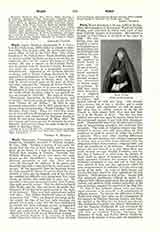

Ward, MARY, foundress, b. January 23, 1585; d. January 23, 1645; eldest daughter of Marmaduke Ward and Ursula Wright, and connected by blood with most of the great Catholic families of Yorkshire. She entered a convent of Poor Clares at St-Omer as lay sister in 1606. The following year she founded a house for Englishwomen at Gravelines, but not finding herself called to the contemplative life, she resolved to devote herself to active work. At the age of twenty-four she found herself surrounded by a band of devoted companions determined to labor under her guidance. In 1609 they established themselves as a religious community at St-Omer, and opened schools for rich and poor. The venture was a success, but it was a novelty, and it called forth censure and opposition as well as praise. Her idea was to enable women to do for the Church in their proper field, what men had done for it in the Society of Jesus. The idea has been realized over and over again in modern times, but in the seventeenth century it met with little encouragement. Uncloistered nuns were an innovation repugnant to long-standing principles and traditions then prevalent. The work of religious women was then confined to prayer, and such good offices for their neighbor as could be carried on within the walls of a convent. There were other startling differences between the new institute and existing congregations of women, such as freedom from enclosure, from the obligation of choir, from wearing a religious habit, and from the jurisdiction of the diocesan. Moreover her scheme was put forward at a time when there was much division amongst English Catholics, and the fact that it borrowed so much from the Society of Jesus (itself an object of suspicion and hostility in many quarters) increased the mistrust it inspired. Measures recognized as wise and safe in these days were untried in hers, and her opponents called for some pronouncement of authority as to the status and merits of her work. As early as 1615, Suarez and Lessius had been asked for their opinion on the new institute. Both praised its way of life. Lessius held that episcopal approbation sufficed to render it a religious body; Suarez maintained that its aim, organization, and methods being without precedent in the case of women, required the sanction of the Holy See.
St. Pius V had declared solemn vows and strict papal enclosure to be essential to all communities of religious women. To this law the difficulties of Mary Ward were mainly due, when on the propagation of her institute in Flanders, Bavaria, Austria, and Italy, she applied to the Holy gee for formal approbation. The Archduchess Isabella, the Elector Maximilian I, and the Emperor Ferdinand II had welcomed the congregation to their dominions, and together with such men as Cardinal Federigo Borromeo, Fra Domenico di Gesu, and Father Mutio Vitelleschi, General of the Society of Jesus, held the foundress in singular veneration. Paul V, Gregory XV, and Urban VIII had shown her great kindness and spoken in praise of her work, and in 1629 she was allowed to plead her own cause in person before the congregation of cardinals appointed by Urban to examine it. The “Jesuitesses”, as her congregation was designated by her opponents, were suppressed in 1630.
Her work however was not destroyed. It revived gradually and developed, following the general lines of the first scheme. The second institute was at length approved as to its rule by Clement XI in 1703, and as an institute by Pius IX in 1877.
At the express desire of Pope Urban Mary went to Rome, and there as she gathered around her the younger members of her religious family, under the supervision and protection of the Holy See, the new institute took shape. In 1639, with letters of introduction from Pope Urban to Queen Henrietta Maria, Mary returned to England and established her-self in London. In 1642 she journeyed northward with her household and took up her abode at Heworth, near York, where she died. The stone over her grave in the village churchyard of Osbaldwick is preserved to this day.
For the history of the institute subsequent to the death of Mary Ward, see INSTITUTE OF MARY.
M. LOYOLA

